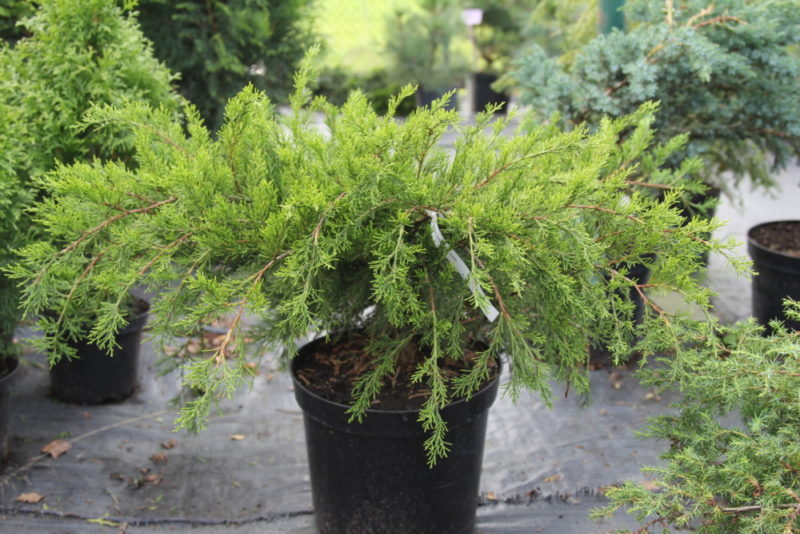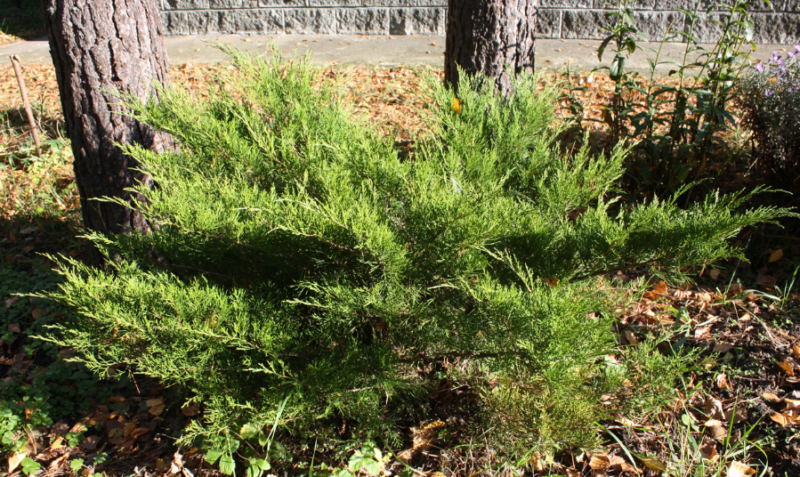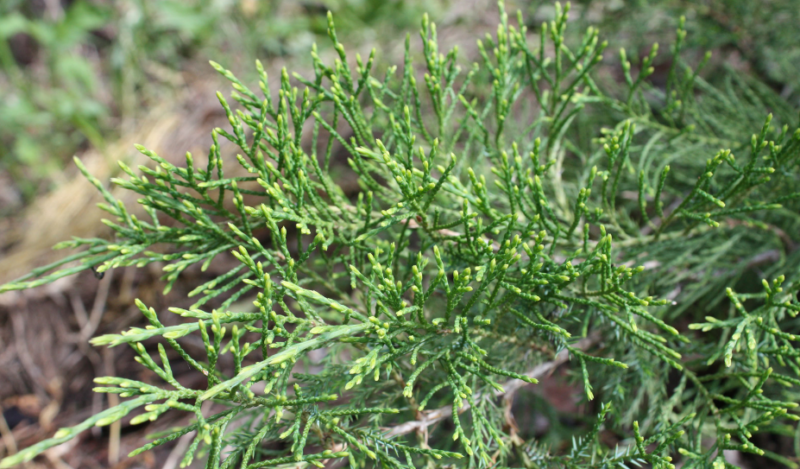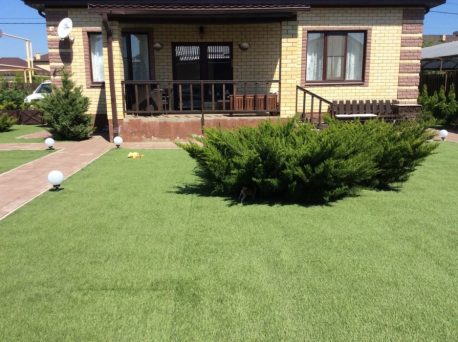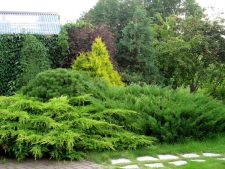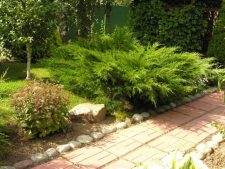Juniper Mint Julep is one of the most popular varieties in Russia and the countries of the former USSR. The shrub is medium-sized, it is actively used in the design of greenhouses, terraces and suburban areas. The beauty of the plant is that it is evergreen, and even in the winter months in the garden green branches against the background of snow-white snow will look luxurious. The description of the variety will allow us to present the picture as a whole, and everyone who wants to plant juniper in their area will understand whether such a shrub is suitable for him or not.
Material Content:
Description of juniper variety “Mint Julep”
Evergreen shrub - a hybrid obtained by breeding juniper Chinese and Cossack. Its crown is spreading, grows at an angle equal to almost 45 degrees. The name "Mint Julep" in translation means "mint cocktail", and was given for the color and pleasant aroma reminiscent of menthol. The variety was bred in the USA, but quickly spread throughout the world.
“Mint Julep” perfectly adapts to any climatic conditions; it tolerates both frosts and heat, both rainy days and drought.
The shrub can be planted both individually and in groups of plants, including other species.
Juniper is low, grows only up to 2 - 2.5 meters. The crown is chic, sprawling, and by the age of ten it can be more than 3 meters in volume. But not only Mint Julep is famous for its fluffy “hairdo”, it also bears fruit. Against the background of emerald needles, cone berries, painted in a bluish color, elegantly flaunt. The fruits are large, reach a size of 2 cm, are poisonous. The plant is a long-liver. On average, its growth period is 100 years.
Outdoor bush planting
The middle juniper "Mint Julep" grows well in the soil of any composition and with any acidity. But in acidified soil, the decorativeness of juniper will decrease, the crown will not be so beautiful. If the pH exceeds the norm, it is advisable to add lime. The plant will become more beautiful and healthy in the drained soil. It can be planted next to other types of juniper.
Ideal is a spring landing.
Before doing the planting, you need to prepare the pits:
- Dig holes from 50 to 70 cm deep, and their width should exceed the diameter of the roots.
- Lay out a five-centimeter drainage layer consisting of chipped bricks or river stones.
- Mix 1/1/2 of the turf land, sand and peat. Pour 1/3 of the wells with this mixture.
- Next, plant the bushes so that the root neck remains on the surface, sprinkle the roots with the same nutrient mixture that was laid out for drainage.
- Water the plants well, tamp the soil, and mulch the area near the trunk.
Care and trimming technology
Caring for juniper is simple; this plant is not picky.
In order for the bush to delight your eyes and be healthy, perform the following procedures:
- Water as the soil dries.
- More succulent needles will be if every evening, after sunset, to spray.
- Loosen the soil after watering as soon as it dries a little. Mandatory cultivation is carried out in the fall, before the onset of frost. This will allow the root system to breathe in the winter.
- In the spring, remove the old mulch, because putrefactive bacteria and pests could multiply in it. Sprinkle a new layer of sawdust or needles.
- Add nitrogen-containing fertilizer, due to which a quick increase in green mass will go.
- Since the branches of the shrub are very flexible, they can break under the weight of the snow. Therefore, you need to connect them together (remember, in what form, before the New Year, Christmas trees are sold).
- For the winter, only young juniper is worth sheltering. Adult bushes perfectly survive even severe frosts and therefore do not need a bedspread.
We should also talk about pruning:
- The bush is formed in the spring, cutting off broken, dry and diseased branches.
- Bottom pruning is rarely done, it is mainly required to remove the tops of the upper branches.
- Throughout the season, the tips of the branches are cut from time to time to maintain the created crown shape.
Shrubs should be examined at least once every 4 weeks for diseases and pests.
Of the diseases, Mint Julep most often suffers from the following:
- rust;
- fungal lesions.
These for the most part occur when juniper grows in the neighborhood of fruit and berry crops.
Pests:
- caterpillars
- aphid;
- mole;
- scale shield;
- sawfly;
- needle tick.
Yellowing, drilling and drying of needles indicate the presence of harmful insects.
To combat diseases and pests, spraying and watering with insecticides, fungicides is used.
There are other reasons why the plant may change color or yellow, this:
- poor drainage;
- insufficiently nutritious soil;
- excessive or weak watering;
- lack of spraying.
Pay attention to these nuances, and urgently change the incorrectly applied care.
Juniper propagation
Female junipers form seeds, but it is almost impossible to grow a new bush from them. Therefore, gardeners for propagation use the vegetative method - cuttings.
Cutting:
- In a young plant, a branch with a length of about 100 mm is cut with a sharp secateurs.
- In the summer, you can plant the cuttings immediately on the bed, and at other times of the year - in the pot.
- Water the soil well, cover with a film at night, creating a small greenhouse around the plant. In the morning, the shelter is removed.
- When the branch takes root, it can no longer be covered with a film. The care is done standard, as described above.
If you need to transplant juniper, do it better in the spring, when the plant grows. They take out a bush, having dug it around the perimeter.They are transferred to a new place with the old lump of earth, where there is already microflora suitable for the plant.
Landscaping Ideas
The bush described in the article will be an excellent addition to any plant ensemble. It is combined with other green crops as well as with flowering ones. Juniper can be decorated with alpine slides, terraces, landscaping the roofs of arbors. But for the most part, juniper is used as a hedge along fences.
The branches of the shrub are very flexible, and this has an important role in landscape design. You can tie them to vertical and horizontal supports, pin them to the ground. Beautifully trimmed bushes will decorate any site anyway; they can be planted near artificial and natural reservoirs, on neatly cut lawns, at the entrance to the house.
Junipers are many grown in decorative pots and put up on the stairs to the house, by the gazebos. The volume of the pot should be, on average, 30 - 40 liters.
In large cities, gardening of parks and squares with juniper is a common thing. The territory with this plant becomes more refined, neat and comfortable. I liked the bush for its excellent decorative appearance. Pleasant color and lush crown allow you to create any composition with other plants, but the juniper itself is quite remarkable.
Try planting shrubs on your site, and you will notice how much it transforms, becomes more beautiful. But to maintain comfort, do not forget to look after the juniper, its decorativeness depends on it.


